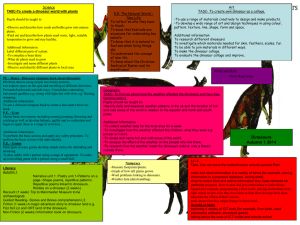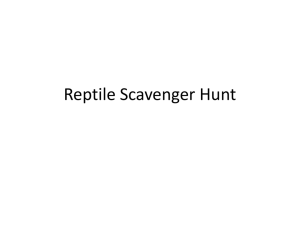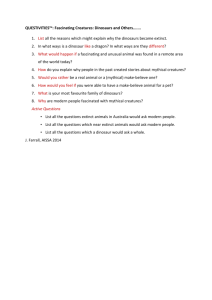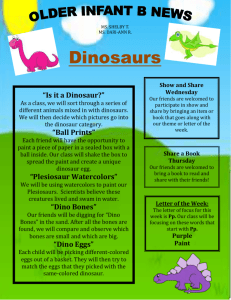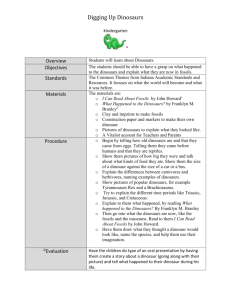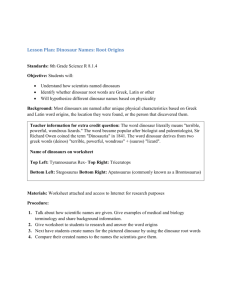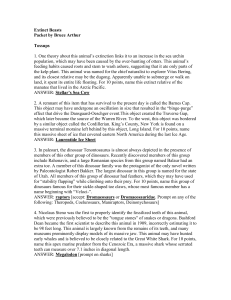Frozen Dinosaurs of Antarctica: Fossils & Biblical Flood
advertisement
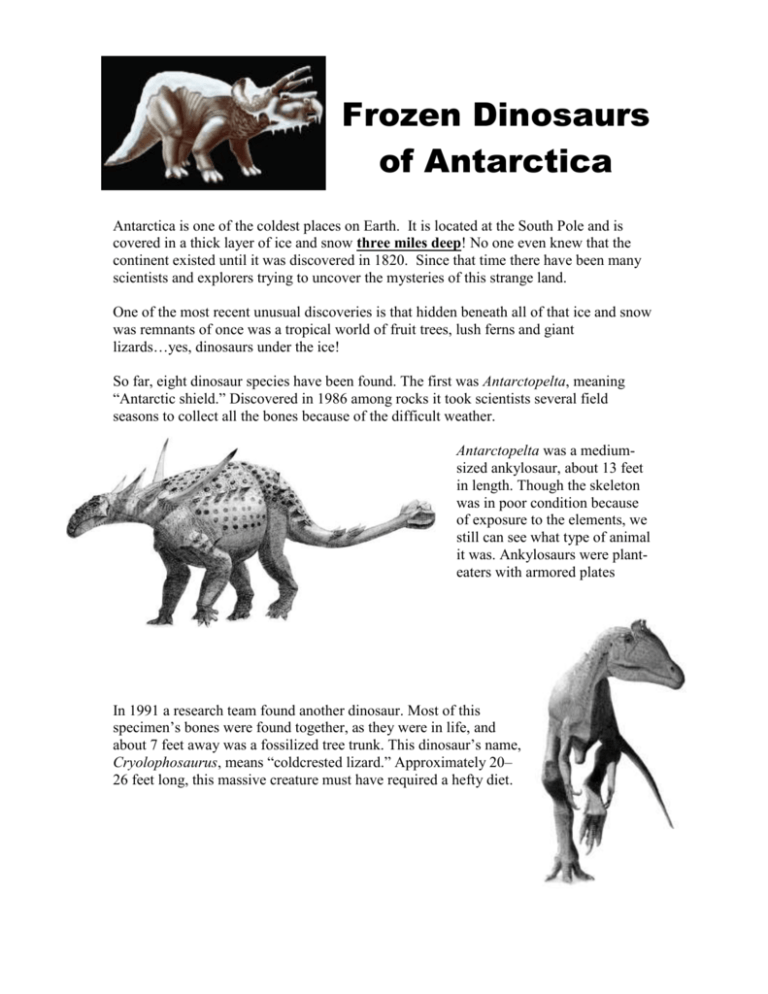
Frozen Dinosaurs of Antarctica Antarctica is one of the coldest places on Earth. It is located at the South Pole and is covered in a thick layer of ice and snow three miles deep! No one even knew that the continent existed until it was discovered in 1820. Since that time there have been many scientists and explorers trying to uncover the mysteries of this strange land. One of the most recent unusual discoveries is that hidden beneath all of that ice and snow was remnants of once was a tropical world of fruit trees, lush ferns and giant lizards…yes, dinosaurs under the ice! So far, eight dinosaur species have been found. The first was Antarctopelta, meaning “Antarctic shield.” Discovered in 1986 among rocks it took scientists several field seasons to collect all the bones because of the difficult weather. Antarctopelta was a mediumsized ankylosaur, about 13 feet in length. Though the skeleton was in poor condition because of exposure to the elements, we still can see what type of animal it was. Ankylosaurs were planteaters with armored plates In 1991 a research team found another dinosaur. Most of this specimen’s bones were found together, as they were in life, and about 7 feet away was a fossilized tree trunk. This dinosaur’s name, Cryolophosaurus, means “coldcrested lizard.” Approximately 20– 26 feet long, this massive creature must have required a hefty diet. Members of the same 1990–91 expedition also collected partial remains of another Jurassic creature called Glacialisaurus, meaning “frozen lizard.” The entire dinosaur must have been 20–25 feet long and weighed an estimated 4–6 tons. This is tentatively identified as a planteating, longnecked dinosaur, or sauropodomorph. Again, this was a big eater. Since these discoveries, a few other dinosaur fossils have been found, including a tooth of a hadrosaur (duckbill dinosaur) unearthed on Vega Island off the Antarctic Peninsula. Although not dinosaurs, large sea reptiles, called plesiosaurs and mosasaurs, have also been found in abundance. For all of these huge creatures to have survived during their existence would have taken a warm, tropical climate with lots of lush green vegetation for them to eat…and that is NOT what Antarctica is today. So what do you suppose happened? The Bible tells us that long, long ago God sent a great flood to destroy the world because man had become so sinful. Only His friend Noah and his family, eight in all and representatives of all air-breathing classes of animals were saved in an enormous boat called an ark. These flood waters covered the entire earth and lasted an entire year before the ark finally landed and everyone was able to come out. During that year of the Great Flood, the earth underwent unbelievable changes. Great mountain ranges where pushed up and deep cracks in the earth’s crust were formed by the forces. Vast deposits of prehistoric forests were buried beneath huge volumes of silt containing bodies of every kind of animal that existed. These great deposits of buried vegetation quickly turned to oil and coal for later use by mankind. The bodies of the animals became fossilized over the next few thousand years by the minerals in the sediment in which they were buried. Above all of this the world had greatly changed. Great land masses were no longer the same with new mountains and lakes where there were none before. Even the air was different. The sky above was different as was the weather. Earthquakes and volcanoes, storms and glaciers reminded the survivors of the Great Flood that their world would never be the same again. All of this should remind us that God takes sin very seriously. The consequences of sin do not just affect us but it affects the entire world in which we live. Paul tells us in Romans 8:22 Rom “For we know that the whole creation groans and labors with birth pangs together until now.” Did You know… Before the Great Flood that it never rained on the earth (Gen. 2:5-6) Noah and his family were the fist people to see a rainbow (Gen. 9:12-14) Seasons were only first mentioned after the Great Flood (Gen. 8:22) which may indicate that prior to the flood the whole world was one climate, even at the poles until they shifted during the flood giving use seasons and weather systems. Many of the dinosaurs quite possibly slowly died out because they could no longer adapt to the tremendous changes in the environment after the Great Flood. The Bible is filled with references about a creature called Tanniym in the Hebrew language. The King James Version of the Bible interprets that word as “dragons”. Since the word “dinosaur” wasn’t invented till the 1800’s, this may have been what the writers of the Bible meant. “Tanniym” may have meant “dinosaurs”. But besides the many references to dragons, the Old Testament described in detail two great creatures that sounded very much like dinosaurs. What were they called? Be the first to tell Tracker Don the answer and receive a reward.

